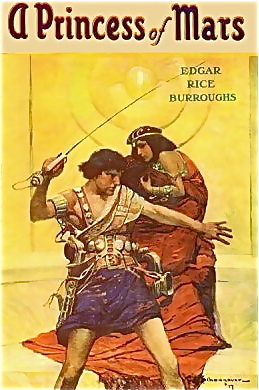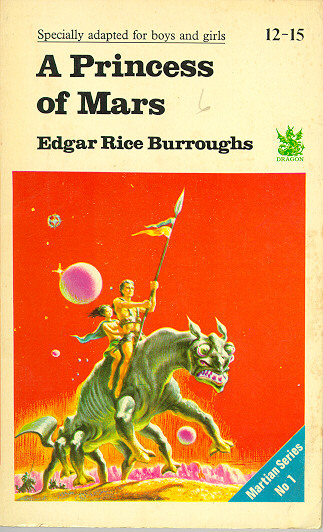Pulp Fantasy Gallery: A Princess of Mars
Since the real world continues to be demanding of late – my apologies for the lighter than normal posting – I've decided to present another entry in the Pulp Fantasy Gallery series. This week, I've opted to go back more than a century, to one of the foundational works of fantasy and science fiction (not to mention roleplaying games), Edgar Rice Burroughs's A Princess of Mars. Long-time readers may recall that I had previously included this book in an early installment of Pulp Fantasy Gallery. In that post, I only highlighted an image of perhaps the most famous – and, in my opinion, best – cover illustration, that by Frank E. Schoonover.
 I'm apparently not alone in my appreciation for this cover, because it was used again and again throughout the ensuing decades. Indeed, it seems to have been the only cover illustration for US editions of A Princess of Mars until the early 1960s, nearly a half-century after its initial appearance. The first new cover illustration of which I am aware is this one by Roy Carnon, from the 1961 Four Square Books paperback edition:
I'm apparently not alone in my appreciation for this cover, because it was used again and again throughout the ensuing decades. Indeed, it seems to have been the only cover illustration for US editions of A Princess of Mars until the early 1960s, nearly a half-century after its initial appearance. The first new cover illustration of which I am aware is this one by Roy Carnon, from the 1961 Four Square Books paperback edition:
 A couple of years later, in January 1963, Ballantine releases this version, with a cover by Bob Abbett. I find it especially interesting, because it looks as if it takes many of its cues from the original Schoonover cover, albeit with the color schemes of John Carter and Dejah Thoris reversed.
A couple of years later, in January 1963, Ballantine releases this version, with a cover by Bob Abbett. I find it especially interesting, because it looks as if it takes many of its cues from the original Schoonover cover, albeit with the color schemes of John Carter and Dejah Thoris reversed.
 In 1968, there's an abridged version of A Princess of Mars from Dragon, a publisher who specialized in children's versions of "classic" stories. The cover artist would seem to be unknown.
In 1968, there's an abridged version of A Princess of Mars from Dragon, a publisher who specialized in children's versions of "classic" stories. The cover artist would seem to be unknown.
 Bruce Pennington provides the very striking cover for the 1969 New English Library edition, which is the first not to depict John Carter.
Bruce Pennington provides the very striking cover for the 1969 New English Library edition, which is the first not to depict John Carter.
 The 1970 Nelson Doubleday/Science Fiction Book Club edition is understandably famous for its use of Frank Frazetta's iconic cover, my second favorite after Schoonover's original.
The 1970 Nelson Doubleday/Science Fiction Book Club edition is understandably famous for its use of Frank Frazetta's iconic cover, my second favorite after Schoonover's original.
 When Ballantine issued a new edition in 1973, it featured this cover by Gino D'Achille:
When Ballantine issued a new edition in 1973, it featured this cover by Gino D'Achille:
 Finally, in 1979, we get the Del Rey edition with Michael Whelan's cover. Because this is the first edition of the novel I ever owned, I retain a certain fondness for it. Apparently, publishers feel similarly, because, like the Schoonover cover before, it's been used again and again since its initial appearance, with editions as recent as just a few years ago still making use of it.
Finally, in 1979, we get the Del Rey edition with Michael Whelan's cover. Because this is the first edition of the novel I ever owned, I retain a certain fondness for it. Apparently, publishers feel similarly, because, like the Schoonover cover before, it's been used again and again since its initial appearance, with editions as recent as just a few years ago still making use of it.

Published on February 05, 2023 21:00
No comments have been added yet.
James Maliszewski's Blog
- James Maliszewski's profile
- 3 followers
James Maliszewski isn't a Goodreads Author
(yet),
but they
do have a blog,
so here are some recent posts imported from
their feed.



